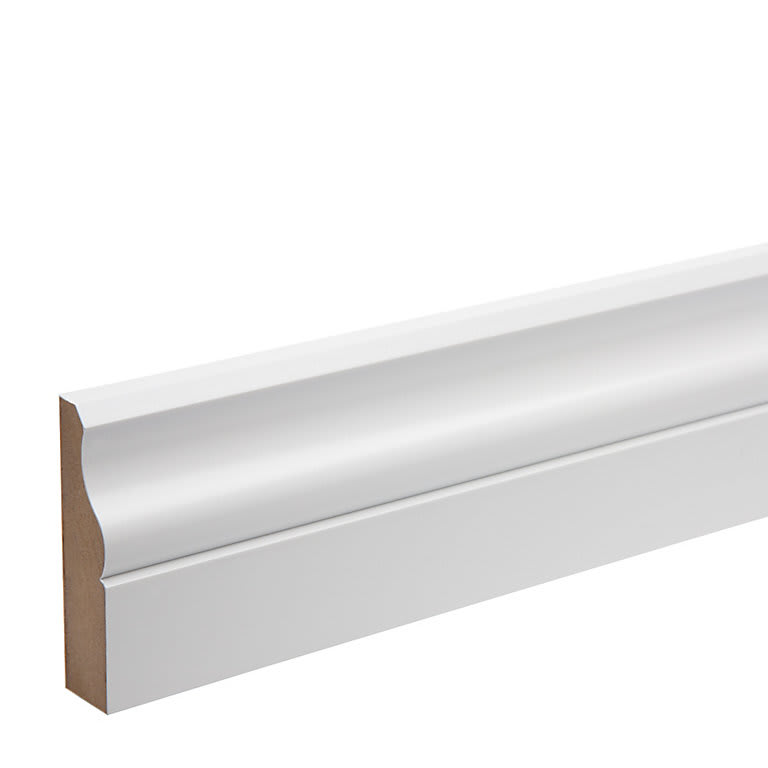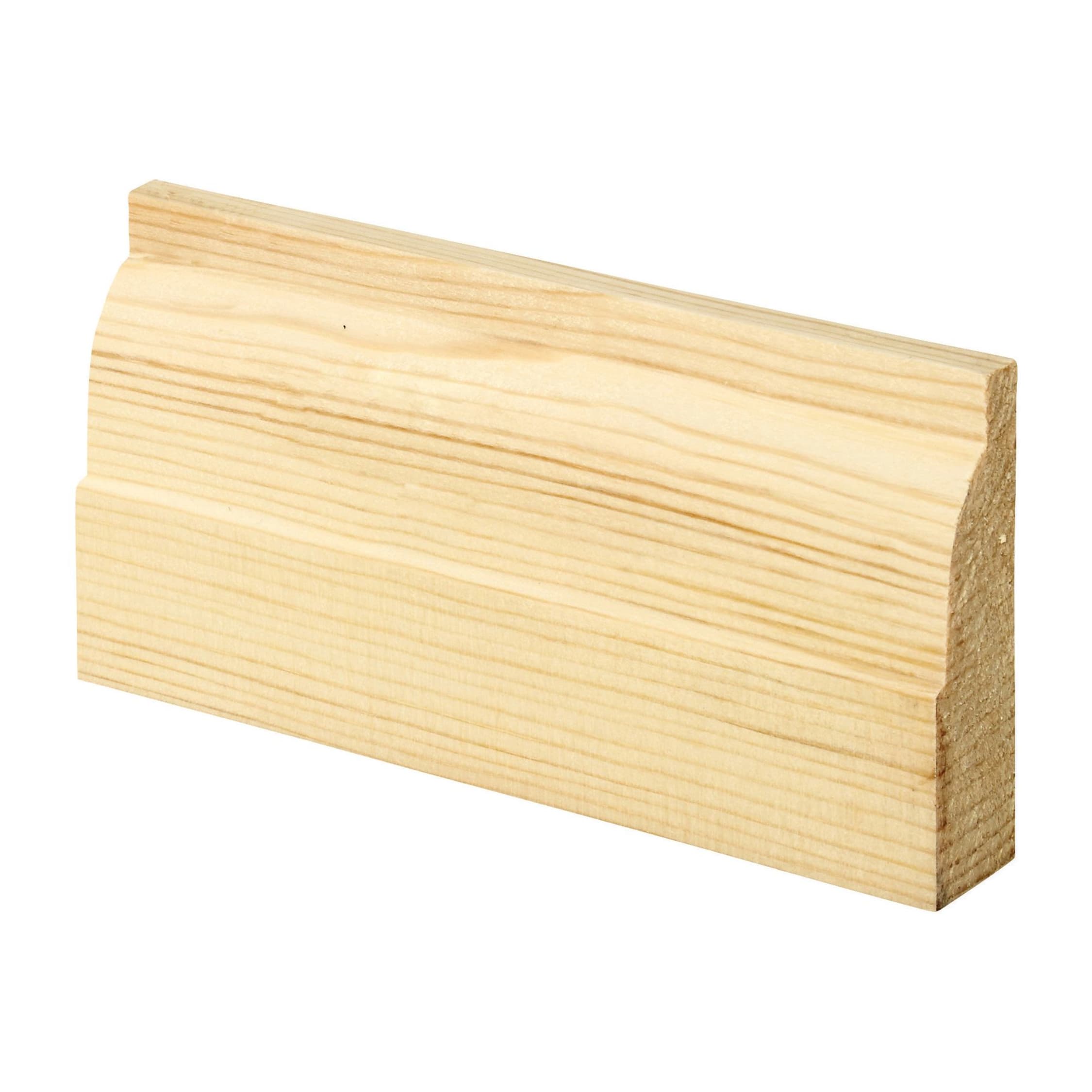Architraves
(11 Products)Architraves are decorative mouldings that frame the perimeter of doors or windows, covering the joint between the frame and wall. They provide a neat transition and help bring consistency to interior detailing.
Available in a range of styles and materials, they can be matched to skirting boards and other trim to create a cohesive interior look.
What Are Architraves?
Architraves bring definition and balance to interior spaces. They create a clear transition between surfaces, helping tie together other decorative elements like skirting boards, coving, and wall panels.
Whether used in traditional homes with intricate period detailing or in modern interiors with clean, minimalist lines, architraves offer great flexibility in style and design.
Functions
- Concealment of Gaps and Imperfections: During construction, it is virtually impossible for a door frame or window frame to meet the surrounding plasterwork or drywall perfectly flush. Architrave effectively hides these unsightly and often uneven construction gaps, providing a seamless and tidy finish.
- Protection of Edges: The edges of plasterwork around doorways and windows are highly vulnerable to chips, knocks, and general wear and tear from daily use. Architrave acts as a durable protective barrier, shielding these delicate areas from damage and preserving the integrity of the wall finish.
- Aesthetic Framing and Definition: Architrave serves as a vital visual frame for doors and windows. By outlining these openings, it elevates them from simple voids to deliberate architectural features. It helps to define the scale of the opening relative to the room and provides a crucial element of visual balance.
- Style Continuity: Architrave is instrumental in tying together the overall design elements of a room. When chosen to complement other mouldings like skirting boards, it contributes to a cohesive visual finish, reinforcing the intended architectural style, whether it's grand Victorian, classical Georgian, or sleek modern.
Architrave Through the Ages
The concept of architrave dates back to classical antiquity, where it referred to the main beam or lintel resting on the columns in Greek and Roman architecture. Over centuries, its role evolved from structural to primarily decorative within interior spaces, adapting to prevailing architectural styles.
- Classical and Georgian Eras (18th Century): Rooted in classical principles, Georgian architrave was often characterised by clean, bold, and symmetrical profiles. Designs like "Chamfered" or simple "Bullnose" were common, reflecting a preference for understated elegance and adherence to classical proportions. Width and depth were significant, complementing the robust nature of Georgian interiors.
- Victorian Era (19th Century): The Victorian period saw an explosion of ornate and elaborate architrave designs. Reflecting the era's industrial capabilities and love for ornamentation, profiles became deeper, more intricate, and often multi-layered (e.g., "Ogee," "ogee and scotia," "lambs tongue"). These designs aimed to convey wealth and grandeur, often reaching impressive widths to frame doorways dramatically.
- Edwardian Era (Early 20th Century): A subtle shift occurred in the Edwardian period, moving towards slightly simpler and wider profiles than their Victorian predecessors. While still decorative, there was a tendency for less intricate carving, reflecting a lighter, more refined classical influence.
- Arts and Crafts & Art Deco (Early-Mid 20th Century): These movements introduced more geometric, simplified, and sometimes stylised profiles. The emphasis shifted from classical ornamentation to craftsmanship and distinct, cleaner lines, suitable for the emerging modern aesthetic.
- Modern and Contemporary Eras (Late 20th Century - Present): Contemporary design embraces minimalism, leading to the dominance of understated profiles like "Pencil Round," "Chamfered," and especially "Square Edge." These designs prioritise clean lines, functionality, and a seamless integration into modern interiors, often specified in wider dimensions for a bolder, yet still simple, statement.
Compatible Profiles
Skirting and architrave is designed to work together, creating a consistent and unified look throughout a space.
Below are compatible profiles to help you match your architraves with the right skirting board style.
- Square Edge Architraves - Square Edge Skirting Board
- Torus Architraves - Torus Skirting Board
- Pencil Architraves - Pencil Skirting Board
- Ogee Architraves - Ogee Skirting Board
- Ovolo Architraves - Ovolo Skirting Board
- Chamfered Architraves - Chamfered Skirting Board
Common Installation Challenges and Solutions
Even for experienced DIYers, installing architrave can present specific challenges that require careful attention:
- Uneven Walls/Door Frames: Walls and frames are rarely perfectly straight or plumb.
- Solution: Use shims behind the architrave to bring it flush with the wall surface where necessary. Minor gaps can be filled with decorators' caulk before painting.
- Inconsistent Mitre Cuts: Incorrect 45-degree angles result in unsightly gaps at the corners.
- Solution: Always use a reliable mitre saw. Cut slightly long and test-fit, gradually trimming small amounts until a perfect joint is achieved. Ensure the saw is accurately calibrated.
- Dealing with Plinth Blocks/Corner Blocks: While simplifying top cuts, these elements require precise sizing and placement.
- Solution: Ensure plinth blocks are wider than both the skirting and architrave to create a visual "step." Corner blocks should be square and positioned symmetrically.
- Securing to Different Wall Types: Fixing to plasterboard, brick, or timber frames requires different approaches.
- Solution: Use appropriate fixings for the substrate (e.g., longer nails/screws for solid timber, smaller pins for plasterboard, or expanding plugs for masonry if direct fixing is needed). Adhesive is crucial to supplement mechanical fixings, especially on less secure substrates.
- Achieving a Flawless Paint Finish: Brush marks, drips, or poor coverage can detract from the overall look.
- Solution: Use high-quality paint brushes or rollers designed for trim. Apply multiple thin coats rather than one thick coat, allowing ample drying time between layers. Maintain a "wet edge" to avoid visible brush strokes.
- Solution: Use high-quality paint brushes or rollers designed for trim. Apply multiple thin coats rather than one thick coat, allowing ample drying time between layers. Maintain a "wet edge" to avoid visible brush strokes.
Frequently Asked Architraves Questions
Are Architraves Necessary?
Architraves aren't strictly essential from a structural standpoint, but they serve important practical and aesthetic purposes.
They cover unsightly gaps between the wall and door or window frame, protect vulnerable edges from damage, and add a finished, cohesive look to a room.
Without architraves, openings can appear unfinished or rough, especially where plaster or paintwork meets timber. In most interior projects, whether traditional or modern, architraves are considered a standard finishing detail.
What Are Architrave Sets?
An architrave door set is an economical and convenient option, providing everything you need to frame a single door/double door, depending on the application in question. These sets (be it a single or double door set) comprise a sufficient amount of architrave, ensuring you have enough material to finish your project.
What Materials Are Used in Architrave Manufacture?
Despite hardwood, softwood and MDF being the most popular materials for architraves, there are a number of other options available on the market including plaster, PVC, rubber, ceramic tiles or even aluminium.
Make sure to take your time when choosing an architrave material that best suits you and your project.
What Is A Primed Architrave?
A primed architrave refers to an architrave that has been pre-coated with a primer or base coat of paint. Primed products tend to receive two coats of good quality primer/basecoat.
Primed finish architraves are commonly available in the market and are designed to save time and effort during installation and painting.
What's more, the priming coats on pre-primed architraves act as a protective layer, helping to seal the surface and protect the architrave from moisture, dust, and other environmental factors. This can enhance the durability and longevity of the architrave, making it more resistant to wear and tear over time.
What Are The Benefits of Water Based Primer?
Water-based primer is applied in a vacuum coater to achieve a consistency that cannot be replicated with old-fashioned methods such as hand spraying.
Water-based primer is utilised to prepare a surface for a final coat of paint. This primer aids the finishing coat of paint to adhere better and results in a more even and spotless finish.
What Is The Difference Between a Door Frame & a Door Architrave?
The main difference between a door frame and a door architrave is their function and placement in relation to a door.
A door frame is the structural framework that surrounds a door and provides support for the door itself. It consists of vertical jambs, a horizontal head, and often a threshold at the bottom.
The door frame is essential for the proper installation and operation of a door, as it provides stability, structural integrity, and a means for attaching the door to the wall.
On the other hand, a door architrave, also known as a door casing or door trim, is a decorative moulding that is used to frame the area around a door opening. It is installed on top of the door frame and covers the joint between the door frame and the surrounding wall.
Can I Paint or Stain Architraves?
Yes, architraves can be painted or stained to match the colour scheme of your room. Wood architraves, in particular, can be easily painted or stained to achieve the desired finish.
It's recommended to use appropriate primers and paints/stains for the material of your architraves and follow proper painting or staining techniques for best results.
Can I Install Architraves Myself or Do I Need Professional Help?
Installation of architraves can be a DIY project for those with basic carpentry skills and experience. However, it's important to have proper measurements, tools, and knowledge of the installation process.
If you're not confident in your skills, it's recommended to seek professional help to ensure proper installation and a polished finish.













